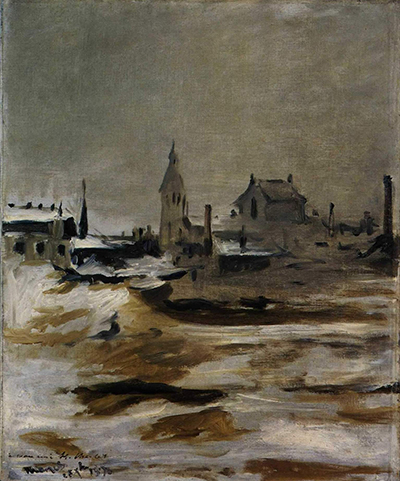Effect of Snow on Petit-Montrouge shows a panoramic view of the suburb on a winter day during the 1870 siege of Paris by the Prussian army.
Manet took part in the war as a member of French National Guard. Petit-Montrouge is situated in the 14th district of Paris. The buildings on the picture are Saint-Pierre church and the surrounding houses. The painting is oil on canvas and it carries an inscription saying: "â mon ami H. Charlet 28 Xbre 1870", most likely a dedication to a fellow soldier. Manet doesn't mention war in the painting's title nor does he depict it directly. The painter expresses his feelings about it in a rather subtle and indirect way through the choice of colours, while the scenery is left as it is in nature.
This is a stark contrast with some other schools, especially from the twentieth century. Picasso's Guernica, for example, shows the impacts of war through the language of symbols and through portraying an interaction of strong negative emotions invoked by such catastrophe with the deeper realms of human unconscious. In Effect of Snow on Petit-Montrouge, the artist is trying to obscure his own conclusions as much as possible. Everything is left as a random bypasser would have perceived it. Ambiguous in its simplicity, the painting has attracted dissonant comments from the critics.
While the critics often concluded that Manet wanted to portray the negativity and hopelessness related to war, there are also views saying that the title Effect of Snow on Petit-Montrouge indicates a somewhat different message. The snow covers the town. Nature gently hides the war's devastating effects and the snow adopts a murky hue in the process. Manet captures the moment which could indicate the beginning of a healing cycle, bound to continue by the resurgence of nature's vitality in spring. While the colours are dark with brown and black dominating the canvass, the underlying ideas expressed through the painting and hinted by its title might as well be inherently optimistic. The original was part of Davies Sisters Collection after being purchased by Gwendoline Davies. It is currently held in National Museum in Cardiff.




